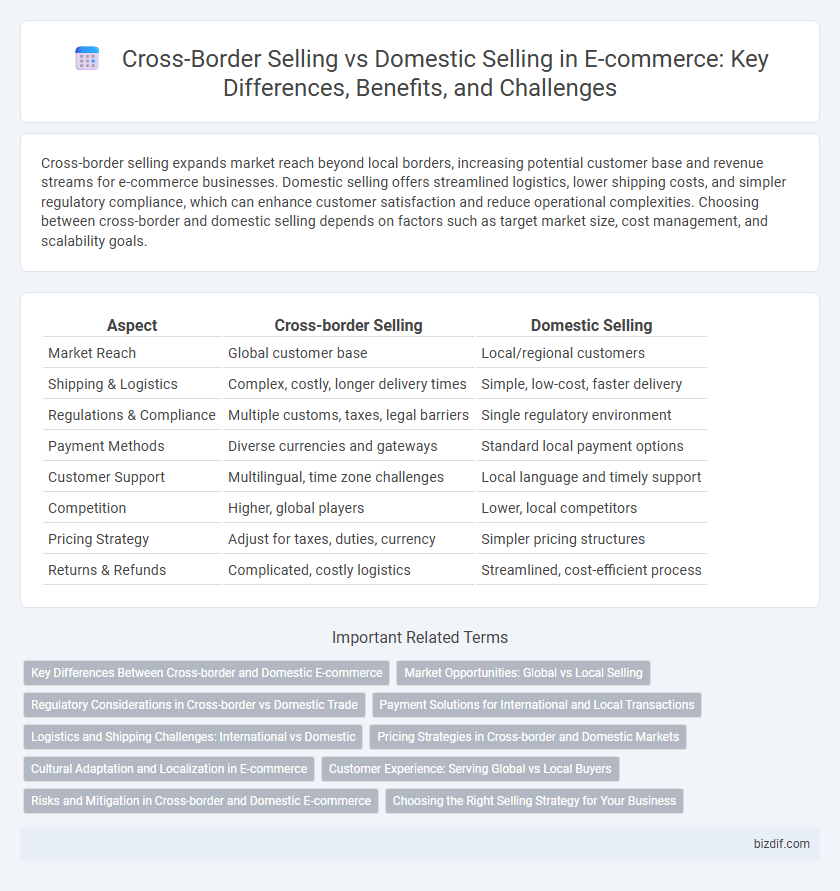Cross-border selling expands market reach beyond local borders, increasing potential customer base and revenue streams for e-commerce businesses. Domestic selling offers streamlined logistics, lower shipping costs, and simpler regulatory compliance, which can enhance customer satisfaction and reduce operational complexities. Choosing between cross-border and domestic selling depends on factors such as target market size, cost management, and scalability goals.
Table of Comparison
| Aspect | Cross-border Selling | Domestic Selling |
|---|---|---|
| Market Reach | Global customer base | Local/regional customers |
| Shipping & Logistics | Complex, costly, longer delivery times | Simple, low-cost, faster delivery |
| Regulations & Compliance | Multiple customs, taxes, legal barriers | Single regulatory environment |
| Payment Methods | Diverse currencies and gateways | Standard local payment options |
| Customer Support | Multilingual, time zone challenges | Local language and timely support |
| Competition | Higher, global players | Lower, local competitors |
| Pricing Strategy | Adjust for taxes, duties, currency | Simpler pricing structures |
| Returns & Refunds | Complicated, costly logistics | Streamlined, cost-efficient process |
Key Differences Between Cross-border and Domestic E-commerce
Cross-border selling involves navigating complex international regulations, currency conversions, and varied shipping logistics, while domestic selling operates within a single country's legal and logistical framework. Customer expectations in cross-border e-commerce require localized marketing, multiple language support, and tailored payment methods, contrasting with the more uniform requirements of domestic markets. Cross-border transactions often face higher costs and longer delivery times compared to the typically faster and cheaper fulfillment processes in domestic selling.
Market Opportunities: Global vs Local Selling
Cross-border selling unlocks access to a vast global market with diverse consumer bases and higher revenue potential, while domestic selling concentrates on familiar local markets with established customer trust. E-commerce platforms enable businesses to tap into international trends and demand spikes, expanding market reach beyond regional limitations. However, domestic selling offers streamlined logistics and compliance, reducing operational complexity and fostering deeper brand loyalty within local communities.
Regulatory Considerations in Cross-border vs Domestic Trade
Cross-border selling involves navigating complex regulatory frameworks, including varying customs duties, import taxes, and compliance with international trade agreements. Domestic selling typically requires adherence to national regulations, which are generally less complicated and more uniform across regions. Understanding these regulatory differences is crucial for e-commerce businesses to optimize compliance, reduce risks, and ensure smooth transaction flows in global and local markets.
Payment Solutions for International and Local Transactions
Cross-border selling requires versatile payment solutions that support multiple currencies, international payment methods, and compliance with local regulations to ensure seamless transactions. Domestic selling typically benefits from streamlined payment gateways optimized for local banks, currencies, and buyer preferences, enabling faster processing and lower transaction fees. Businesses leveraging global payment processors like PayPal, Stripe, or Adyen can effectively manage both international and local payments, enhancing customer experience and reducing cart abandonment rates.
Logistics and Shipping Challenges: International vs Domestic
Cross-border selling faces complex logistics challenges including customs clearance, longer shipping times, and higher costs compared to domestic selling, where shipping is faster and more predictable. International shipments require detailed documentation, compliance with varying import/export regulations, and coordination with multiple carriers, increasing the risk of delays and added expenses. Domestic selling benefits from streamlined delivery networks and standardized regulations, resulting in more efficient and cost-effective shipping operations.
Pricing Strategies in Cross-border and Domestic Markets
Cross-border selling pricing strategies must account for currency fluctuations, international shipping costs, and varying tax regulations, which often require dynamic pricing models to remain competitive and profitable. In contrast, domestic selling typically allows for more stable price points due to consistent regulatory environments and lower logistical expenses, enabling businesses to focus on localized promotions and competitive pricing within a familiar market framework. Understanding these distinctions is crucial for e-commerce businesses aiming to optimize margins and customer acquisition in both international and domestic markets.
Cultural Adaptation and Localization in E-commerce
Cultural adaptation and localization are crucial in cross-border e-commerce to address diverse consumer preferences, languages, and purchasing behaviors, enhancing user experience and trust. Domestic selling often benefits from standardized marketing strategies and uniform product offerings, while international markets require tailored content, payment options, and customer support to succeed. Effective localization increases conversion rates and customer retention by respecting regional holidays, local regulations, and cultural nuances unique to each target market.
Customer Experience: Serving Global vs Local Buyers
Cross-border selling requires tailored customer service strategies to accommodate diverse languages, cultural preferences, and international shipping policies, enhancing the shopping experience for global buyers. Domestic selling focuses on streamlined logistics, localized payment options, and familiar communication styles, ensuring convenience and trust for local customers. Optimizing customer experience through targeted support improves satisfaction and loyalty in both international and regional e-commerce markets.
Risks and Mitigation in Cross-border and Domestic E-commerce
Cross-border selling in e-commerce involves higher risks such as currency fluctuations, customs delays, and compliance with diverse international regulations, which require strategies like dynamic currency conversion, reliable logistics partnerships, and thorough legal research to mitigate. Domestic selling faces lower regulatory complexity but still encounters challenges like local competition and regional tax variations, mitigated through localized marketing and efficient inventory management. Both models benefit from robust fraud detection systems, but cross-border e-commerce demands enhanced security protocols due to increased vulnerability to international cyber threats.
Choosing the Right Selling Strategy for Your Business
Cross-border selling expands market reach by tapping into international demand, offering higher revenue potential but requiring compliance with diverse regulations and shipping logistics. Domestic selling ensures easier inventory management and customer support while maintaining lower operational risks and currency exposure. Evaluating your business capacity, target audience, and supply chain capabilities is crucial to selecting the optimal sales strategy that maximizes profitability and growth.
Cross-border Selling vs Domestic Selling Infographic

 bizdif.com
bizdif.com